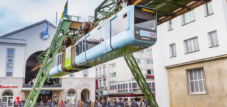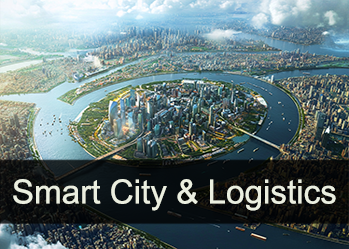City logistics / Urban Logistics – Urban logistics, also called city logistics or metropolitan area logistics
Language selection 📢
Published on: June 5, 2023 / update from: June 19, 2023 - Author: Konrad Wolfenstein

Urban city logistics, also called city logistics or metropolitan area logistics - Image: Xpert.Digital / metamorworks|Shutterstock.com
What does urban logistics deal with in the context of urbanization and smart city concepts?
Urban logistics deals with the organization and optimization of freight transport in urban areas in order to address the logistical challenges associated with urbanization and smart city concepts. It covers various aspects including the transportation, storage, distribution and management of goods in urban environments. In the context of urbanization and smart city concepts, urban logistics plays an important role in creating sustainable, efficient and environmentally friendly logistics solutions. Here are some key areas that urban logistics deals with in this context:
Last mile and micro distribution
The last mile refers to the transport of goods from the distribution center to the end user. Urban areas face challenges such as traffic restrictions, limited space and environmental impacts. Urban logistics solutions aim to improve last-mile efficiency and sustainability through alternative delivery methods such as bicycle couriers, electric vehicles or drones.
Suitable for:
Smart supply chains
By using technologies such as Internet of Things (IoT), telematics, real-time data and predictive analytics, smart city concepts can be integrated into logistics to optimize the flow of goods. Smart supply chains enable effective inventory management, route optimization and real-time tracking of shipments.
Environmentally friendly solutions
Urban logistics solutions in the context of smart cities aim to reduce the environmental impact of freight transport. This includes the use of electric vehicles, hybrid vehicles, alternative fuels and low-emission delivery methods to reduce carbon emissions and air pollution.
City Consolidation Centers
These centers serve as transshipment points for goods transport in urban areas. By bundling goods deliveries from different suppliers, empty trips can be avoided and the efficiency of goods transport can be increased.
Integration of transport modes
Urban logistics involves the integration of various modes of transport such as road, rail, water and air to make freight transport more efficient. This can include the use of multimodal solutions, such as combining truck transport with rail or using river shipping.
Reverse logistics
Urban logistics also deals with handling returns, recycling and reusing packaging materials, and waste disposal in urban areas. Reverse logistics systems aim to reduce resource consumption and ensure efficient disposal and recycling of materials.
Reverse logistics deals with managing and processing the return flow of goods, packaging and materials along the supply chain. Unlike traditional logistics, which focuses on the forward flow of products from the manufacturer to the end user, reverse logistics deals with the reverse flow, which includes taking back, repairing, reusing, reselling or disposing of products and materials.
New solution and logistics concepts
New solution and logistical optimization concepts to consolidate the possibilities and expand functionality that exist in urban areas - such as: B. in cemeteries (Smart Columbarium).
The Smart Park or Smart Columbarium concept
The Smart Columbarium concept describes the possibility of reducing the space required for cemeteries by an impressive 90%. This innovative solution creates valuable space that can be used to create green leisure and recreation parks. This measure aims to increase the culture of well-being in the community and to provide residents with an attractive environment for their leisure activities.
More about it here:
- Smart Park: New green parks thanks to Smart Columbarium
Access code / password : daifuku
City Consolidation Centers
City consolidation centers, also known as city consolidation centers or urban consolidation centers, are logistics infrastructures that were specifically developed for urban areas. Its main goal is to improve the efficiency of urban supply chains and reduce the negative impact of urban freight transport.
Suitable for:
Here are some important aspects of the City Consolidation Centers:
Collection and consolidation of goods
City Consolidation Centers serve as central hubs for receiving shipments of goods. They allow the collection of goods from different suppliers and the consolidation of these goods into larger shipments that are then delivered together into the city. This reduces the number of trips and delivery vehicles.
Efficient route planning
By consolidating deliveries in a central hub, efficient routes for inner-city delivery traffic can be planned. This reduces congestion, traffic congestion and environmental impact as there are fewer delivery vehicles on the road.
Envelope and sorting
City Consolidation Centers provide facilities for the handling and sorting of goods. Here the incoming deliveries are unloaded, checked, sorted and distributed to the appropriate delivery vehicles. This ensures that supplies are properly prepared for distribution.
Multimodal transport
City Consolidation Centers offer the opportunity to use different modes of transportation to handle the last mile in urban areas. This may include the use of delivery vehicles, bicycles, e-cargo bikes or other environmentally friendly means of transport. By integrating different transport modes, the CO2 emissions and environmental impact of freight transport in the city are reduced.
Collaboration with suppliers and retailers
City Consolidation Centers work closely with suppliers, retailers and other supply chain actors. This includes coordinating delivery times, arranging collection points for goods and efficiently handling logistics processes. By collaborating with supply chain stakeholders, City Consolidation Centers can continuously optimize logistics processes. For example, route plans are improved, delivery times are adjusted or capacities are used more efficiently. The goal is to increase logistical efficiency and reduce environmental impact.
Close collaboration between City Consolidation Centers, suppliers and retailers is therefore crucial to fully exploit the benefits of these logistics infrastructures and ensure an efficient, sustainable and transparent supply chain.
City logistics or metropolitan area logistics
City logistics or metropolitan area logistics refers to a series of concepts that aim to make urban freight transport more efficient, reduce traffic loads and minimize negative environmental impacts.
City logistics is an important concept in the context of urbanization and sustainable city management:
Bundling freight transport
A central approach in city logistics is the bundling of freight transport. This means consolidating deliveries from different suppliers and retailers to reduce the number of vehicles on the roads. By bundling, empty runs can be avoided and efficiency gains can be achieved.
Use of transshipment points
City logistics concepts rely on the use of transfer points where goods are transferred from larger vehicles to smaller means of transport. These transshipment points act as interfaces between long-distance deliveries and distribution in urban areas. This reduces congestion in city centers and allows deliveries to be made using more environmentally friendly vehicles such as electric vehicles or bicycles.
Multimodal transport
City logistics often involves the use of various transport modes to handle freight traffic in the city. In addition to road vehicles, alternative means of transport such as rails, waterways or cargo bikes are also used. This helps to relieve road traffic and reduces noise and environmental pollution.
Efficient route planning
Another important aspect of city logistics is efficient route planning. By using technologies such as GPS, traffic data analysis and intelligent logistics systems, deliveries can be planned to avoid traffic jams and unnecessary miles. This saves time, energy and resources.
Use of sustainable means of transport: City logistics increasingly focus on the use of sustainable means of transport in order to reduce the environmental impact. Electric vehicles, hydrogen vehicles, bicycles and other eco-friendly options are preferred to reduce carbon emissions and air pollution in urban areas.
Cooperation between actors
City logistics requires close cooperation between different actors such as suppliers, transport companies, retailers and public institutions. Through cooperation and coordination, synergies can be created, resources shared and common solutions found.
Urban logistics or metropolitan area logistics
Metropolitan area logistics or urban logistics and similar concepts aim to relieve the urban infrastructure, increase the economic efficiency of urban freight transport and at the same time ensure a constant quality of supply. The focus is on the receiving point of the flow of goods, where the logistics are organized and brought together. Instead of the previous practice in which different goods were delivered to different receiving points, metropolitan area logistics strives to bring different goods to common receiving points.
Metropolitan area logistics can be viewed as an entrepreneurial organization of freight transport trips, where the goal is to optimize utilization and minimize the number of trips in metropolitan areas. It includes all operational and planning activities that relate to the efficient provision or disposal of real goods in a city. This includes matching the type, quantity, time, space and environmental factors of goods to meet needs.
While the first definition primarily emphasizes the economic aspect of metropolitan area logistics, the second definition also takes the ecological aspect into account. However, there is no clear definition of the term because both aspects are closely linked and metropolitan area logistics pursues both economic and ecological goals. It is about ensuring the sustainable and efficient provision of goods in the city in order to reduce traffic congestion, reduce emissions and improve the quality of life of the urban population.
Metropolitan area logistics therefore represents a holistic approach that takes both economic and ecological aspects into account and aims to increase the efficiency and sustainability of urban freight transport. By combining flows of goods and optimizing logistics processes in metropolitan areas, resources can be used efficiently and environmental impacts minimized.
Concepts of urban logistics
Freight transport center
Freight transport centers (GVZ) are transport industry areas with independent transport companies/branches and system change points for the transport modes (preferably: road, rail, water, air). They enable cooperation between all those involved to achieve synergy effects. GVZs are connecting points between local and long-distance transport as well as the interface between modes of transport.
It should be noted that this is one of various definitions that express the same content.
One goal of the development of the GVZ is to relieve the burden on the roads from freight traffic and to promote the use of the more environmentally friendly modes of transport, rail and waterways. In this context, an essential component of a GVZ is a terminal for combined cargo transport (KV terminal). This enables containers, swap bodies and semi-trailers to be changed efficiently.
The aim of the development of a nationwide freight transport network with regard to the establishment of combined transport terminals is to provide “night jumps” between the individual locations in order to be competitive with road freight transport in terms of time.
With the establishment of freight transport centers at the interface between local and long-distance transport, both positive economic and ecological goals are achieved. Examples include the ecological concerns of avoiding urban sprawl in metropolitan areas and relieving inner cities of heavy goods traffic.
Economic effects are e.g. B. the savings in high pre- and on-carriage costs due to the spatial proximity of the modes of transport to one another. This also enables local companies to optimize the transitions between modes of transport and local and long-distance transport in an environmentally and cost-effective manner through cooperation under one organizational roof (location company) (keyword: city logistics).
Transshipment terminals
Terminals for combined freight transport as an interface between at least two modes of transport (usually rail/road) can be located both in the city center and on the outskirts of metropolitan areas. They represent the interface between local and long-distance transport. The most common variant is integration into freight transport centers. The transshipment can be carried out using mobile equipment, the so-called reach stackers, as well as with gantry cranes with a capacity of approx. 50,000 loading units/year. A track length of around 700 meters is ideal for loading or unloading so-called block trains. Combined transport in Germany is currently recording growth rates. The so-called seaport hinterland traffic is becoming increasingly important. The containers from overseas are transported directly to the domestic terminals by rail.
Cooperations between freight transport companies
Freight transport companies that have decided to work together can use subcontractors who collect the shipments for the individual recipients from the participating cooperation partners and then deliver them in a bundle. It is not absolutely necessary that the subcontractors unload, re-sort and reload the shipments in their own transshipment warehouses. It is sufficient if e.g. B. there are enough re-sorting areas available at a freight transport company that was last served.
Disposal logistics (reverse logistics)
In addition to the supply, apart from receiving the returned goods, logistics for collecting recyclables and waste are also necessary.
Xpert.Plus city logistics consultation with Konrad Wolfenstein
Xpert.Plus is a project from Xpert.Digital. We have many years of experience in supporting and advising on storage solutions and in warehouse optimization , which we bundle in a large network Xpert.Plus
I would be happy to serve as your personal advisor.
You can contact me by filling out the contact form below or simply call me on +49 89 89 674 804 (Munich) .
I'm looking forward to our joint project.
Xpert.Digital – Konrad Wolfenstein
Xpert.Digital is a hub for industry with a focus on digitalization, mechanical engineering, logistics/intralogistics and photovoltaics.
With our 360° business development solution, we support well-known companies from new business to after sales.
Market intelligence, smarketing, marketing automation, content development, PR, mail campaigns, personalized social media and lead nurturing are part of our digital tools.
You can find out more at: www.xpert.digital – www.xpert.solar – www.xpert.plus



























